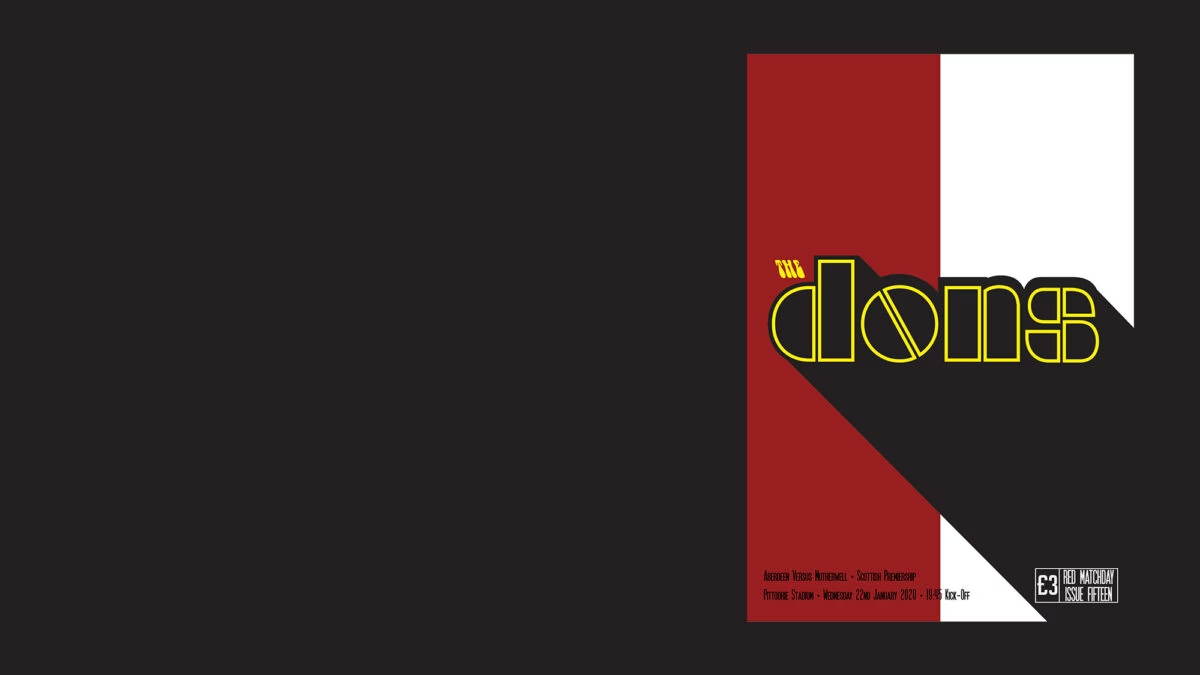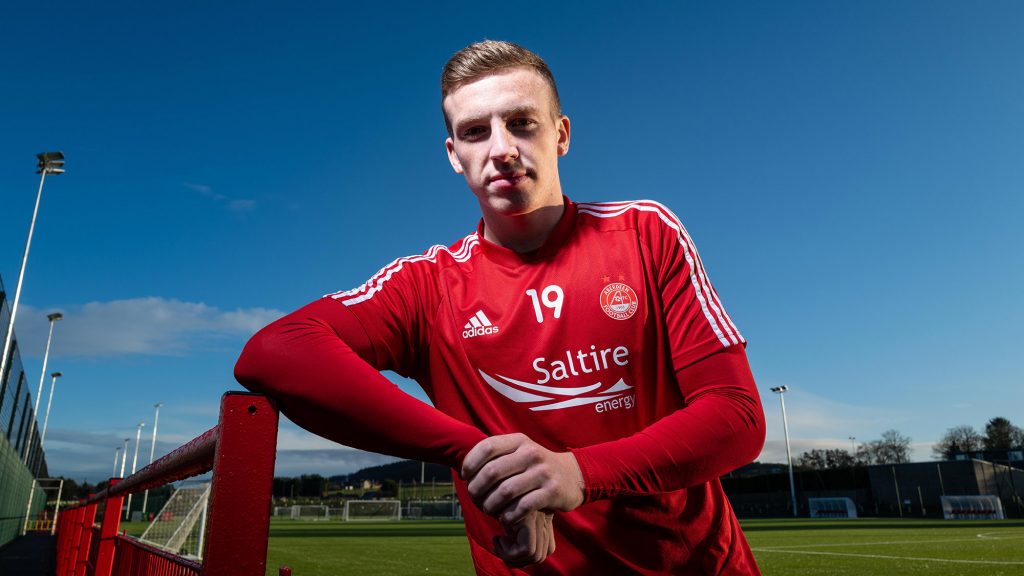News

Red Matchday Issue 15 | Preview
In issue 15 of Red Matchday Magazine there is an interview with Lewis Ferguson who sat down and had an in depth chat with the programme editor.
The first half of the season was a challenging one at times for the Dons, the squad stretched by a string of injuries. That was particularly true in the midfield area, one player after another succumbing across the opening months of the campaign. That put a real onus on those who were able to get out on the field, not least Lewis Ferguson, who, suspension aside, has been an ever present this term, again showing remarkable consistency for someone so young. Lewis has stepped up to the increased responsibility that he’s had to shoulder, adding to his all-round game with plenty of assured performances.
He’s hoping for more competition for places in midfield during the second half of the season …
… “As a team, we didn’t have the experience we wanted in there, but I’m in a position where you need to take responsibility. It’s something I would never shy away from. I enjoy it and it can only help me as a player and as a person. I have enjoyed it on a personal level. I have played week in, week out. Every game I have been available for I have played, so I’m happy and loving my football.
… “It’s been great to have Funso back in the midfield over the last few games as a calm and experienced head. He is a very good player. He puts his foot on the ball, moves it around. He has got good experience, so it helps me as well, gives me a bit more freedom. He likes to sit deeper and get on the ball and protect the back four. That allows me the freedom to go and make some forward runs.
… “He brings a composure to the team that we needed. Just someone that will put their foot on the ball and control the tempo of a game.
… “The position he plays, the holding midfielder, it is a role that can go unnoticed. It is a difficult job at times, especially when teams are putting pressure on you but he is the sort of player that you need in there.
… “Dylan is an exciting signing too. I played against him when I was youngster at Accies and he is a very good player. There’s no doubt he is a huge talent. He is also someone that can come in who has got experience as well as being a good footballer. Like Funso, he can put his foot on the ball and dictate a game. He is a massive addition to the team and will make us so much stronger in the middle of the park.”

The player Q&A is with Bruce Anderson. This plus all the usual features, columns and extensive history section. Red Matchday is priced at £3.00 and is available to buy in and around the ground, in the club shop and online by clicking here
Tonight’s Dolly Digital designed cover is inspired by the late 1960s and The Doors. The Doors were an American rock band formed in Los Angeles in 1965, featuring lead vocalist Jim Morrison. Their iconic logo first appeared on the cover of their self-titled debut album and then on the cover of the 1968 album “Waiting for the Sun”. It’s one of the most famous band logos due to the employment of simple, bold geometric shapes as well as the reflective double O letters.
The world was changing in the late sixties, and if there was one season in post war Aberdeen FC history that reflected that, then 1968/69 more than any other was a transitional period for the club.
After coming close to success in 1967, Turnbull moved away from the ‘seasoned pro’ approach and went for the guile and craft of the likes of Jimmy Smith and Tommy Craig. It was a gamble that was to convince Turnbull that his preferred technical approach may not be best suited for the rough and tumble of Scottish football. The free scoring side of 1967 was changing as Turnbull looked to find a winning combination.
Turnbull brought in former Rangers centreforward Jim Forrest from Preston NE in what was a club record £25,000 deal in the summer. He also bought Tommy Rae from Partick. Turnbull was adopting a more flamboyant approach to his side with the emphasis firmly on his flair players. It was a shift in direction for the Aberdeen manager who had previously gone with the tried and trusted type of player with a low risk factor. The League Cup section proved to be a mixed bag as Aberdeen finished just outside of qualifying; two defeats to Clyde proved their undoing.
It was still very much a learning curve in Europe for Aberdeen. They negotiated a tricky trip to Sofia in the opening round of their Inter-Cities Fairs Cup tie. After a 0-0 draw in Bulgaria, the Dons beat Slavia Sofia 2-0 in the Pittodrie return. In the second round, they came up against real quality in Real Zaragoza from Spain. A late Tom McMillan goal in the Pittodrie tie only gave the Dons a precarious 2-1 lead to take to Spain. A comprehensive 3-0 defeat in front of a frenzied Spanish crowd in the return was a harsh lesson for Turnbull and his team.

SEASON 1968/1969
ABERDEEN
The Aberdeen first team squad.
As one of the strangest anomalies that football often throws up, after a disastrous spell in November, the Dons found themselves near the foot of the old 18-team top division.
Crucially, two heavy defeats at Dunfermline (1-5) and at home to Hibernian (2-6) prompted Turnbull to sensationally axe Scotland keeper Bobby Clark from the first team. Reserve team keeper Ernie McGarr was drafted into the side and the Fifer went on to not only keep Clark out of the side, but later that season he also replaced him in the Scotland side as he gained two full caps against Austria and Ireland. Remarkably in 1969 Aberdeen had two full international keepers both earning caps for Scotland.
Later that summer both Jimmy Smith and Tommy Craig were sold for record fees; Craig became the first £100,000 teenager in Britain when he joined Sheffield Wednesday. Jimmy Smith was sold to Newcastle United for £80,000. Turnbull ditched the craft for a more technical and methodical approach. His efforts were soon to be rewarded the season after.
One major facelift at Pittodrie for the new season was the changes made to the old grandstand at the ground. The enclosure in front of the seated area was demolished in the summer and new seating and dug outs were built with a new perimeter wall. The club also announced that Pittodrie was now called Pittodrie Stadium, replacing the old Pittodrie Park. The old stand had been completed in 1928 and 40 years on, the upgraded facility was regarded as one of the best in the country and would now be called the Main Stand. Also included in the improvements was the new public bar that was opened under the new seating which was well frequented by the Main Stand patrons of the time. The club also considered putting an enclosure over the south terrace but at a cost of £250,000, they opted to upgrade the grandstand area.

SEASON 1968/1969 Pittodrie Park becomes Pittodrie Stadium
